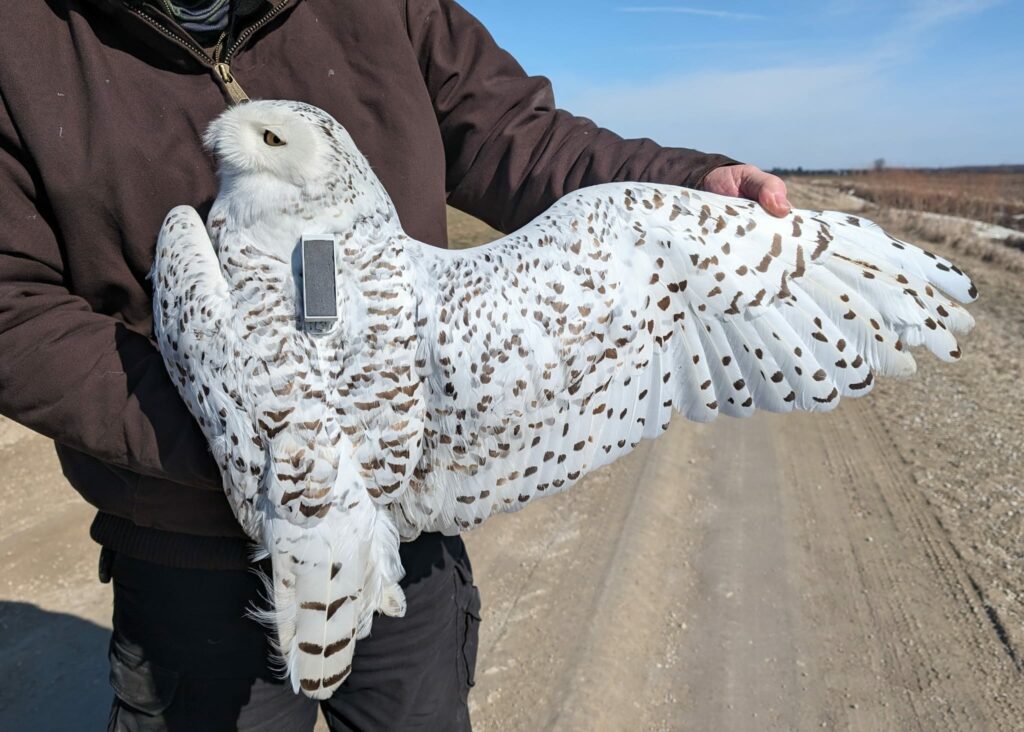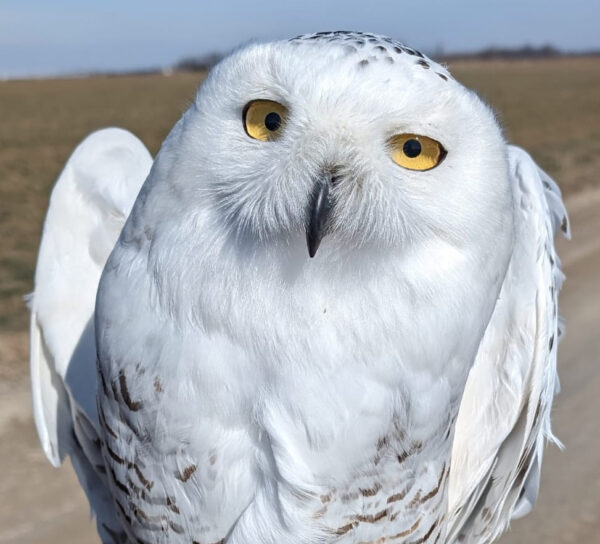
Atwood, an after-third-year female (meaning she is at least four years old), was tagged in southern Ontario Feb. 25. (©Charlotte England)
On Feb. 25, SNOWstorm collaborators Charlotte England and Malcolm Wilson tagged an adult female snowy owl, which they nicknamed Atwood for a nearby small town in southern Ontario. She weighed a healthy 2,170 grams (4.8 pounds) and based on her flight feather molt is at least four years old. We look forward to tracking her movements for years to come.

Atwood, ready for release. (©Charlotte England)
For the time being, however, we are not going to publish Atwood’s tracking map. She’s already attracted the attention of local photographers, and while thus far everyone seems to be behaving themselves (and in any event focusing more on a couple of all-white adult male snowies that have appeared in the area, rather than her), we think it would be prudent for now not to publicize her whereabouts, even with the 24-hour delay we place on all of our mapping data.
We are increasingly concerned by the commercial exploitation of snowy owls by what we consider to be unscrupulous photo tour operators who use live mice to bait snowies in for large numbers of paying photographers. This is deeply unethical, as guidelines from organizations like the National Audubon Society and International League of Conservation Photographers make clear, because owls — especially naive juvenile snowy owls — are easily habituated to humans feeding them. Such owls are much more likely to approach humans in general, and we know from long experience that people are by far the biggest threat to wintering snowies. That’s why, for example, most legitimate nature and wildlife magazines have strict policies banning photos of baited raptors, as well as those of other harassed or manipulated wildlife. (It should go without saying that there are fairly obvious differences between training an owl to come at a whistle for tossed mice, and someone, say, photographing birds at a backyard feeding station.)
While we believe the practice of baiting owls is unethical, like a lot of unfortunate behavior it may not be illegal, depending on the location. One hotspot for this kind of baiting is the farmland west of Ottawa, several hours from where Atwood is, where several tour operators have access to private farmland and charge thousands of dollars per client for snowy owl photo tours, carrying live pet store mice in coolers to toss out to prompt action shots for the group. But as officials at the Ontario Ministry of Natural Resources and Forestry point out, provincial baiting laws were written to cover hunting, not photography, and unless local municipalities decide to take action at their level, there is little the ministry can do about it — except agree that the practice is highly unethical.
Over the years, Project SNOWstorm has developed excellent relationships with a number of ethical photographers who do not bait owls, and we’ve been grateful when they’ve shared their images of our tagged birds. We’re not painting with a broad brush here, but we have zero patience for photographers who put getting a great shot over the welfare of the animal they’re photographing.
Once Atwood moves out of the area, or becomes less consistent with her location, we will lift the curtain and publish her tracking map. And obviously, any time we think there’s a risk from our publishing even time-delayed tracking data for any bird, we will shut down that owl’s map as well.


17 Comments on “Introducing Atwood”
As a wildlife/bird photographer I have become truly dismayed at the behavior of some of my compatriots. I live in an area that attracts a yearly influx of Snowy Owls & I have seen some truly egregious unethical behaviors to get that ‘trophy’ shot. I see the same behavior regarding other charismatic raptors like Long-Eared Owls & Burrowing Owls in my area. Our avian friends should not be turned into commodities for our personal consumption in ways that degrade their lives & the lives of those who observe them. Each photographer trespassing or getting too close seems to think ‘they are the only one’ and how can it hurt? I point out that they are only one of many. This kind of behavior got a very rare Northern Hawk Owl shot by an incensed landowner in my area. I’ve seen landowners put up debris & barriers to dissuade an owl from utilizing a favored roosting spot. This grieves me & has given me 2nd thoughts about my own impact on my annual visitors.
PS: Remember kids – it isn’t all about you all of the time.
Hey Christy – thanks for pointing out the dangers of “loving too much” It’s difficult but try not to get angry at the unthinking. They don’t mean to hurt the birds ( or other wildlife) and anger creates more anger. What I’ve learned in the years I’ve been running Destination; Wildlife is that being friendly, reminding folks that the first best practice in watching or photographing birds and wildlife is to keep them healthy – and that means not disturbing them by getting too close. That is followed quickly by consideration for landowners (read: habitat owners) . Annoyed landowners make for displaced – or dead – birds and wildlife as you have clearly seen. And our #1 advice to all who see irresponsible action: Be a good example. Do the right thing. Believe it or not – your quiet right actions do have a positive impact over time. Scott Weidensaul has written some great articles on the subject of responsible bird viewing. Who would know better?
Thank you for keeping Atwood (and all “our” owls) safe and standing firm on the side of the animals safety first. Look forward to seeing her movements whenever the time is right.
Very good choice to keep Atwood’s location private. I enjoy the updates on the Snowy Owls.
Thank you for keeping Atwood safe. Safe from people who just don’t care.
I was recently banned from an owl “education” page for expressing my disgust at a photographer who posted a photo of a snowy and commented that over 1000 photographers were also there shooting. If they were truly trying to educate, that type of post wouldn’t be allowed. Thank you, Scott and Project Snowstorm, for all you do to foster real education about these incredible birds.
As a seasoned wildlife photographer, I am deeply dismayed by this trophy like behavior. Like all wildlife, the owls should not be harassed and kudos to Project SnowStorm for keeping them safe. I would encourage you to doxx these unscrupulous tour operators.
oh wow – i had no idea photo tour operators were doing that. terrible. i’d be happy with no map locations and just hearing and learning about the owls you all are tracking. the behavior is fascinating.
Goes to show how careful we need to be when “liking” wild life images on social media which could in turn further drive this type of trophy “shooting” behaviours.
Baiting snowies is awful. I hope the pics I’ve liked on social media are taken under ethical circumstances. I would actively avoid unethical photography if I knew it to be the case.
A quick reply and thank you to everyone who has weighed in on this. Like you all, we’re deeply troubled by this sort of behavior and are looking into ways we can raise the profile of the problem more widely. Not every photographer who signs up for one of these tours realizes they’re abetting unethical and (for the owl) very dangerous activities. We’ll be working with prominent, ethical wildlife photographers who are similarly sickened by this kind of destructive behavior to warn away those who may not realize what a “snowy owl photo tour” actually entails. But it’s sometimes hard to overcome what is basically greed, both commercial and photographic.
As someone who lives close to the farmland west of Ottawa that you speak of, thank you for speaking out against this practice. And to everyone else who has commented here, thank you as well. Owl-baiting has been a significant issue in our region for well over a decade now. I have heard stories of habituated Snowy Owls flying up to people and making begging noises, or following them from telephone pole to telephone pole as they drove down agricultural roads looking for Snow Buntings or Horned Larks. This sickens me. It also sickens me that these so-called “wildlife” photographers throw mice – yes, literally throw! – at the owls for the sake of a few pixels.
Part of what makes owls so beautiful is their independence, their wildness, their majesty and their mystery. The habituated owls that have been constantly baited are anything but. They have been turned into street performers, forced to perform when the photographer demands it. That is not nature. Such practices should be illegal now that the owls are listed as “vulnerable” due to population declines, but sadly, I think Snowy Owls would have to be become endangered before authorities decide to step in and pass laws against baiting. The owls deserve better.
Gillian, thank you, you’ve expressed it much better than I can!!! We’ve seen the Owl-baiters and “wildlife” photographers in the west Ottawa area and also have a Snowy Owl follow us from telephone pole to telephone pole in another rural area while birding for snow buntings and larks.
I would hope authorities finally do something about this disgusting practice.
Thank you for protecting Atwood and keeping her location quiet, and thanks so much for speaking out about the dreadful practice of baiting snowy owls . Is very distressing to see this happening and if you say something to the photographers they get upset. We’ve seen the “photo tours” guides with the coolers with mice in those west Ottawa farm fields you talk about, and elsewhere as well. It’s disgusting how they choose profit over the welfare of wildlife.
Hang on – there IS something that can be done:
“But as officials at the Ontario Ministry of Natural Resources and Forestry point out, provincial baiting laws were written to cover hunting, not photography, and unless local municipalities decide to take action at their level, there is little the ministry can do about it — except agree that the practice is highly unethical.”
If an agency spokesperson said that, it is at best horribly apathetic, and at worst a blatant disregard for their public duty to protect sensitive wildlife. Canadian or Provincial laws can be amended or newly drafted, if it serves the best interest of the country or province. Clearly this behavior is not only unethical it has factually documented adverse impacts on sensitive wildlife such as Snowy owls and other species.
If the agency won’t proactively do what is needed, then Canadian or provincial citizens can (and must) demand this activity be banned from their elected officials that have the authority to make such a change.
I can’t disagree with a word you wrote, Jeff. One of the folks fighting this in the Ottawa area got a rather mealy-mouthed response from the ON MNRF (“There are many different perspectives on wildlife management and finding a balance between protecting natural resources and the diverse interests of Ontarians is always a challenge.”) Folks can apply pressure at the ministry level, but there is also the avenue of residents in the municipalities where the commercial baiting is taking place bringing the problem to the attention of their local officials.